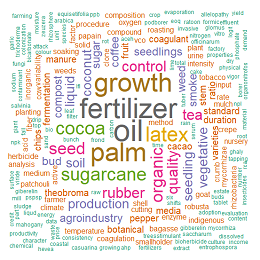Analisis Efisiensi Kinerja Rantai Pasok Teh di PT Perkebunan Nusantara I Regional II Unit Sinumbra, Perkebunan Sinumbra Menggunakan Metode Data Envelopment Analysis (DEA)
DOI:
https://doi.org/10.25181/jaip.v13i1.3900Keywords:
data envelopment analysis, performance efficiency, PTPN I Regional II Sinumbra, supply chain, teaAbstract
Regional II Sinumbra Unit is a state-owned company. Tea is a Superior commodity that has high export opportunities. PTPN I Regional II Sinumbra Unit is a state-owned company that maintains and processes black tea products. The production of black tea involves the performance of the supply chain of high-quality black tea products. The purpose of this study was to determine the efficiency value of the tea supply chain performance of the five regions in the Sinumbra Plantation. Data collection by interview and secondary data analysis on the head of the production, head of the field section, and several staff at PTPN I Regional II Sinumbra. The method used is the Data Envelopment Analysis (DEA) method with DEAP 2.1 software to analyze the efficiency of supply chain performance. Supply chain flows include goods, financial, and information flows. The results showed that region I afdeling II is an area that has high efficiency compared to the other five regions with an average of 0.689. Each region produces a fairly good efficiency value with an average vulnerability of 0.568-0.689.Downloads
References
Abdul, M., Soleh, R., & Hutomo, M. (2024). Analisis efektivitas manajemen rantai paok dan produksi teh (studi kasus pada Pabrik Teh Sumber Daun Putra Takokak). Jurnal Masharif Al-Syariah: Jurnal Ekonomi dan Perbankan Syariah, 9(3), 1497–1505. https://doi.org/10.30651/jms.v9i3.22809
Apriyani, D., Margaretha, F., & Santosa, W. (2022). Analisis pengaruh praktek manajemen rantai pasokterhadap kinerja ekspor dengan mediasi kinerja rantai pasok. Jurnal Ilmiah Indonesia, 7(12), 17194–17216. https://doi.org/10.36418/syntax-literate.v7i12.10518
Ayu, L., Indradewa, D., & Ambarwati, E. (2012). Pertumbuhan, hasil dan kualitas pucuk teh (Camellia sinensis (L.) Kuntze) di berbagai tinggi tempat. Vegetalika, 1(4), 78-89.
BPS. (2024). Statistik Teh Indonesia. Direktorat Statistik Tanaman Pangan Hortikultura dan Perkebunan.
Duwimustaroh, S., Astuti, R., & Lestari, E. R. (2016). Analisis kinerja rantai pasok kacang mete (Anacardium occidentale Linn) dengan metode data envelopment analysis (DEA) di PT Supa Surya Niaga, Gedangan, Sidoarjo. Industria: Jurnal Teknologi dan Manajemen Agroindustri, 5(3), 169-180.
Fatimah, S., & Mahmudah, U. (2017). Pengukuran efisiensi kinerja sekolah dasar lewat model data envelopment analysis. Jurnal Cakrawala Pendidikan, 36(2), 233-243.
Latifah, S. W., & Yuliati, U. (2019). Dimensi kompetitif lingkungan rantai pasokan upaya mencapai keunggulan bersaing UMKM di Malang. Jurnal Manajemen dan Bisnis, 4(1), 41–53.
Manumono, D., & Listiyani. (2023). Kajian perkembangan teh di Indonesia. AGRIFITIA: Journal of Agribusiness Plantation, 2(2), 133–146. https://doi.org/10.55180/aft.v2i2.281
Miftakhurrohman. (2022). Analisis Daya Saing dan Determinan Teh di Negara Tujuan Ekspor Utama [Unpublished undergraduate thesis, Universitas Tidar].
Prasetiyo, B. D., & Takaya, R. (2024). Strategi pengelolaan rantai pasok dalam industri manufaktur untuk meningkatkan efisiensi. Jurnal Kajian Ilmiah Interdisiplinier, 8(7), 2118–7303.
Pratiwi, S. A., & Andriyani, D. (2021). Pengaruh luas lahan teh dan produktifitas tehterhadap ekspor teh di Indonesia tahun 1985 sampai 2019. Jurnal Ekonomi Pertanian, 4(1), 29-37.
Puarada, S. H., Gurning, R. N. S., & Harahap, W. U. (2020). Efisiensi teknis rantai pasok jagung tingkat petani dan pengumpul dengan metode Data Envelopment Analysis (DEA) Kecamatan Batang Kuis, Deli Serdang, Sumatera Utara. Agro Bali: Agricultural Journal, 3(2), 234–245. https://doi.org/10.37637/ab.v3i2.629
Pusat Penelitian Teh dan Kina. (2022). Statistik Teh 2024. PPTK. https://iritc.org/statistik-teh-indonesia/
Sa’diyah, N. H. (2016). Analisis efisiensi menggunakan metode Data Envelopment Analysis (DEA) (Kasus pada PT. Indonesia Toray Sinthetic). Sains: Jurnal Manajemen dan Bisnis, 9(1), 101-119.
Saputri, D. L., Ichwani, T., & Nawasiah, N. (2024). Pengaruh manajemen rantai pasokan terhadap kinerja perusahaan dan keunggulan bersaing sebagai variabel intervening pada PT Mukti Lintas Media. JIMP, 4(1), 24–31.
Wardoni, I., & Dharmawati Putri, D. (2024). Analisis efisiensi rantai pasok lateks dengan metode Data Envelopment Analysis (DEA) di PT Perkebunan Nusantara IX Kebun Krumput Banyumas. Jurnal Pertanian Agros, 26(1), 70–81.
Widiyati, L. (2017). Analisis Efisiensi Kinerja Rantai Pasok (Supply Chain) Produk Olahan Salak Lokal dengan Menggunakan Metode Data Envelopment Analysis (DEA) pada UD. Halwar Indoraya Jombang [Unpublushed undergraduate thesis, Universitas Brawijaya].
Downloads
Published
How to Cite
Issue
Section
License
Copyright (c) 2025 Mira Santika Dewi, Devi Maulida Rahmah, Irfan Ardiansah, Faizal Syahmurman

This work is licensed under a Creative Commons Attribution-ShareAlike 4.0 International License.
Authors who publish with Jurnal Agro Industri Perkebunan agree to the following terms:
Authors retain copyright and grant the Jurnal Agro Industri Perkebunan right of first publication with the work simultaneously licensed under a Creative Commons Attribution License (CC BY-SA 4.0) that allows others to share (copy and redistribute the material in any medium or format) and adapt (remix, transform, and build upon the material for any purpose, even commercially) with an acknowledgment of the work's authorship and initial publication in Jurnal Agro Industri Perkebunan.
Authors are able to enter into separate, additional contractual arrangements for the non-exclusive distribution of the journal's published version of the work (e.g., post it to an institutional repository or publish it in a book), with an acknowledgment of its initial publication in Jurnal Agro Industri Perkebunan. Authors are permitted and encouraged to post their work online (e.g., in institutional repositories or on their website) prior to and during the submission process, as it can lead to productive exchanges, as well as earlier and greater citation of published work.


























